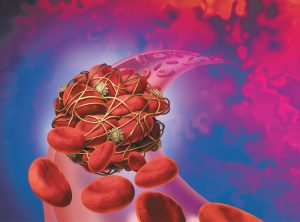 The pandemic has heightened attention to the dangers of blood clots including deep vein thrombosis, pulmonary embolism and clot-provoked stroke. According to the National Blood Clot Alliance (NBCA), blood clots kill 274 Americans each day when they restrict blood flow and cause a medical emergency. While different types of blood clotting are being reported among people affected by COVID-19, particularly those who become severely ill after infection with the virus, everyone is at risk for blood clots regardless of age, gender or race.
The pandemic has heightened attention to the dangers of blood clots including deep vein thrombosis, pulmonary embolism and clot-provoked stroke. According to the National Blood Clot Alliance (NBCA), blood clots kill 274 Americans each day when they restrict blood flow and cause a medical emergency. While different types of blood clotting are being reported among people affected by COVID-19, particularly those who become severely ill after infection with the virus, everyone is at risk for blood clots regardless of age, gender or race.
Obesity, smoking, hypertension and a personal or family history of blood clots increase your chances of developing clots. Women’s risk is increased by birth control pills, pregnancy and hormone replacement therapy. People at the highest risk include those with clotting disorders, atrial fibrillation (a-Fib), cancer, traumatic injury, lengthy immobility and surgery.
Three steps can help with prevention of blood clots – maintain a healthy weight, stay hydrated and move regularly. Drinking plenty of water and fluids helps keep your blood from thickening. Particularly when sitting for long periods such as on flights or car trips, get up and walk every 60 to 90 minutes and stretch your calf muscles frequently to keep the blood flowing in your legs.
Individuals with aFib should talk with their physician about the benefits and risks of taking a blood thinner to reduce the risk of clots and stroke.
Know the symptoms so you can get help quickly, potentially saving your life or the life a friend or family member. The Centers for Disease Control and Prevention documents symptoms for blood clots in deep veins of your leg and thighs include increased leg swelling, skin that is warm to the touch, red or discolored, pain in a leg that feels like a pulled muscle but not caused by injury, tightness, cramping or soreness, or a throbbing sensation. If you experience any of these signs or symptoms, alert your doctor as soon as possible.
“If you suspect you have blood clots please reach out to your medical provider. Timely diagnosis and prompt treatment can save your life,” said Dr. Argyrios Tzilinis, M.D., Vascular Surgeon with Physicians Regional Medical Group.
The most common signs and symptoms of a pulmonary embolism caused by a blood clot that is blocking blood flow in the lungs are difficulty breathing, chest pain that worsens with a deep breath or cough, coughing up blood and a faster-than-normal or irregular heartbeat. Seek medical treatment immediately when you experience any of these signs and symptoms.
To schedule an appointment with Dr. Tzillinis, please call 239-348-4221 or visit PhysiciansRegionalMedicalGroup.com.
Dr. Argyrios Tzillinis, M.D. is conveniently located at Physicians Regional-Pine Ridge Medical Office Bldg. 6376 Pine Ridge Rd., Naples, FL 34119, Physicians Regional Collier Medical Arts Building 8340 Collier Blvd and our Walden Center in Bonita Springs at 24231 Walden Center Drive.








